Beetroot paratha is a delicious whole wheat flatbread stuffed with a spiced and savory beetroot filling. There are many variations of stuffed parathas and this beet flatbread is one such healthy variation. It makes for a filling breakfast or brunch and can be easily made for a lunch box.

These stuffed beetroot parathas are made with grated beetroots and a good way to use any leftover beetroot. They have a faint sweet taste coming from the beetroots.
Stuffed parathas are made with various grated veggies and even mashed potatoes. parathas can be served for breakfast, brunch or lunch. These beetroot parathas can also be packed in the tiffin box.
Generally in the morning hours, making parathas can become too much of work. So You can knead the dough at the night and keep it in the fridge. Then make the beetroot stuffing in the morning.
You can also grate the beetroot a night before and store it in a small airtight box. So kind of easy while making the parathas for breakfast or tiffin box or lunch box.
This recipe is a no onion no garlic paratha. If you want to check some more recipes made with beetroot then you can check this link of 14 Beetroot Recipes.
These beetroot parathas can be served as it is or with a side of Mango Pickle or mango chunda or even curd or raita.
They can also be packed for a tiffin box. You can easily double or triple this recipe if you want to make more parathas.
How to make Beetroot Paratha
Preparing the paratha dough:
1. First take 2 cups whole wheat flour, ½ teaspoon salt and 2 teaspoon oil in a mixing bowl or pan. Mix very well.
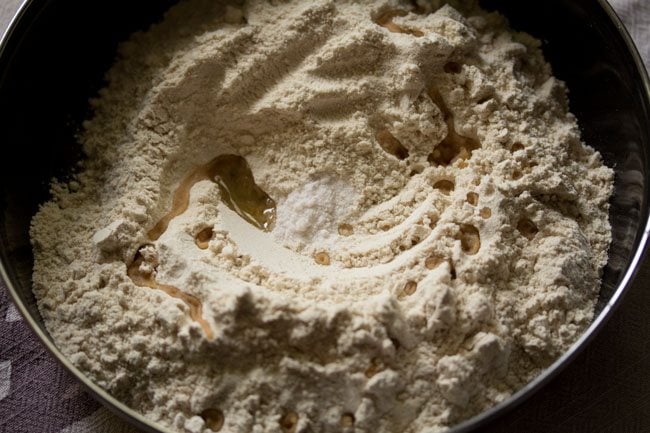
2. Then add ½ cup water.
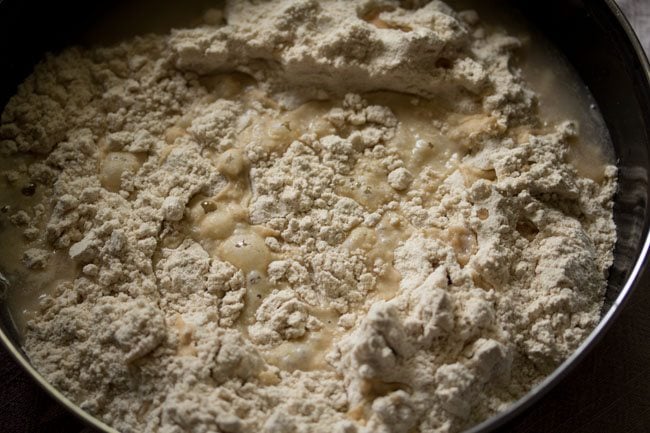
3. Begin to knead. Add more water if required while kneading. I added overall ⅔ cup water. Depending on the quality of flour, you can add less or more water.
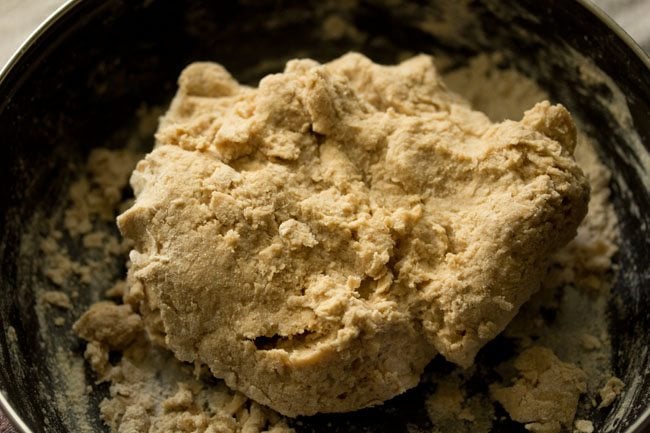
4. Knead to a soft and smooth dough. Cover the bowl with a lid and keep aside for 30 minutes.
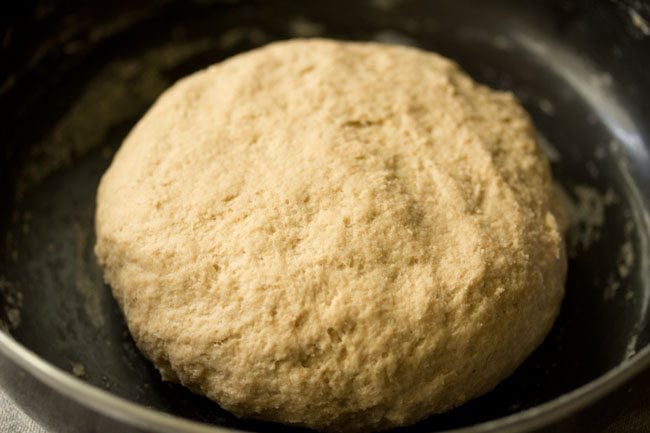
Preparing beetroot stuffing
1. Rinse, peel and grate 350 grams beetroot or 4 medium-sized beetroots. You should be able to get 2 cups of tightly packed beetroots.
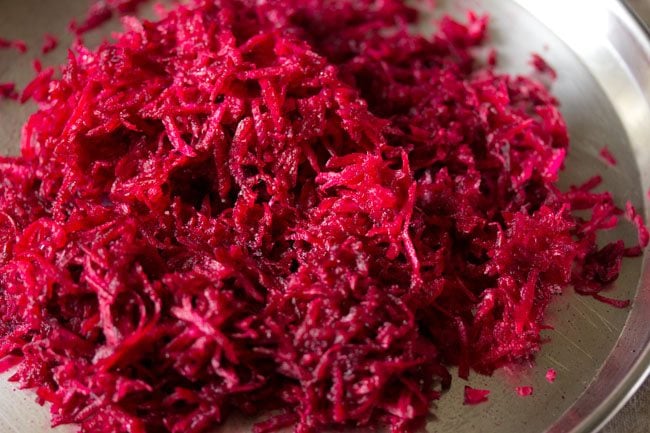
2. Heat a frying pan and add 1 teaspoon oil. Then add the grated beetroot. You can use any neutral flavored oil.
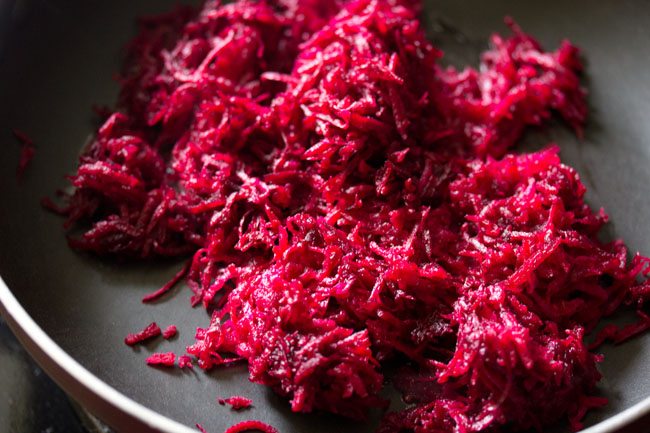
3. Saute the beetroot on low heat for 5 to 6 minutes, till there is no moisture in them. They will be partly cooked and also appear dry.

4. Now add the following seasonings – 1 to 2 green chilies (finely chopped), 1 teaspoon amchur powder or dry pomegranate powder, ½ teaspoon garam masala powder and salt as required.
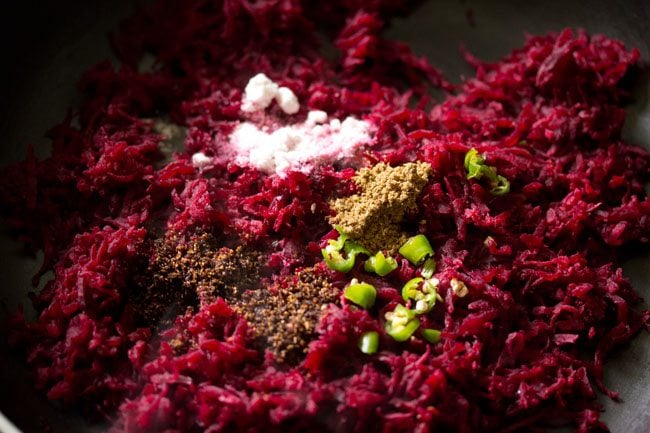
5. Mix very well. Switch off the heat. Keep the beetroot mixture aside.
Make sure there is no water or liquids in the beetroot stuffing mixture. Or else the paratha will become soggy while rolling and roasting.

Assembling and preparing beetroot paratha
1. Pinch medium sized balls from the dough. Roll them and keep them covered.
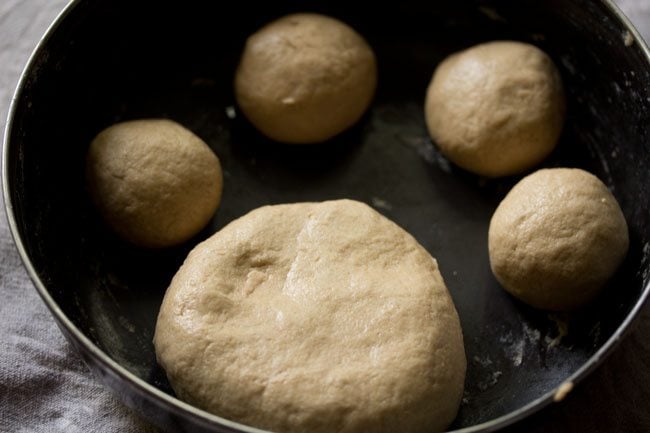
2. Take a dough ball on a rolling board. Flatten it a bit. Sprinkle with some whole wheat flour.
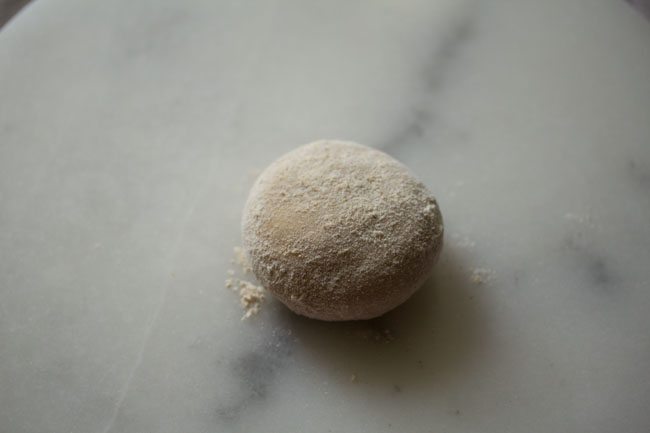
3. Roll to a round of 5 to 6 inches in diameter.

4. Place 2 to 3 tablespoons of the beetroot stuffing on the rolled dough.
TIP 1: Don’t overstuff as then stuffing can come out while rolling or roasting paratha.
TIP 2: Don’t under stuff as then you won’t get the flavors and taste of beetroot filling. With experience, you will come to know the right proportion of the filling to be used in the paratha.

5. Begin to pleat the edges.
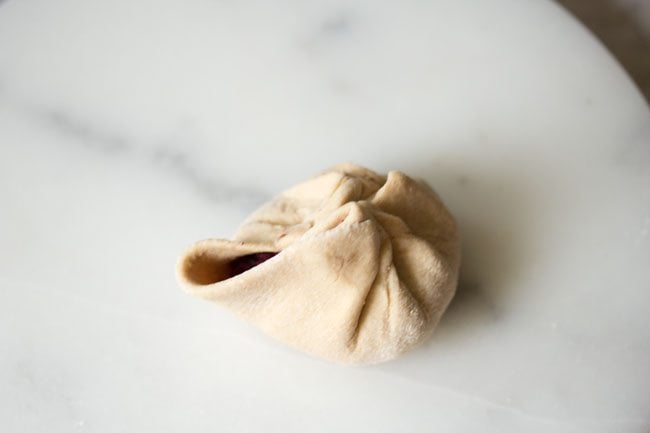
6. Then bring them together at the center and press them at the center.
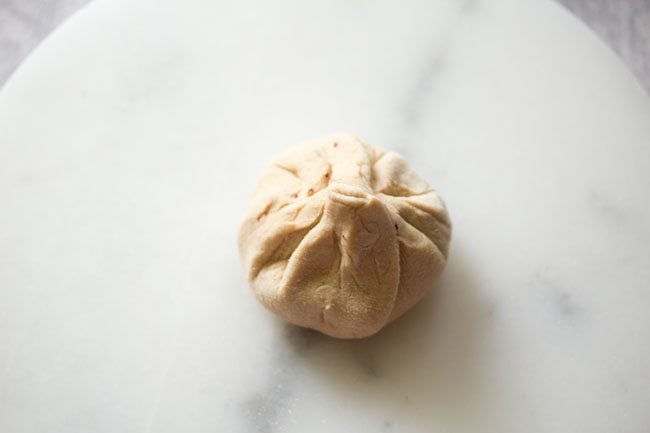
7. Flatten the pressed edges with your fingers and dust some flour on the stuffed dough.
You can also roll two small rounds and then place the beetroot stuffing between the dough circles. This method is shown in this Aloo paratha recipe. You can choose either of the methods that you find easy.

8. Gently roll to a paratha of about 7 to 8 inches. Sprinkle flour as required while rolling.
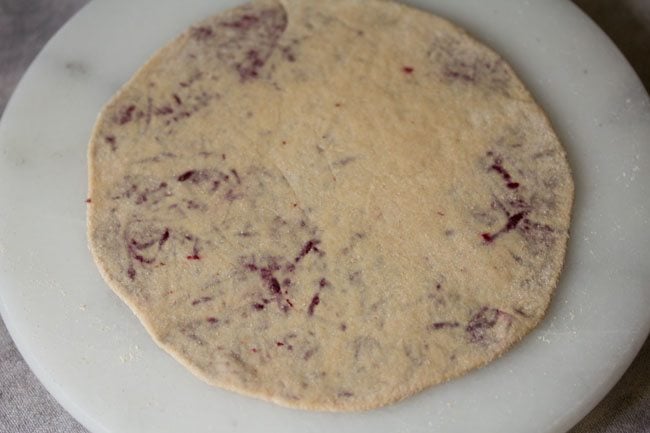
Cooking Beetroot Paratha
9. Heat a tawa or skillet and let it become hot. Place the paratha on the hot skillet. Keep the heat to medium-high or high. Never roast the paratha on low flame as then they become dense or hard and you don’t get the best taste.
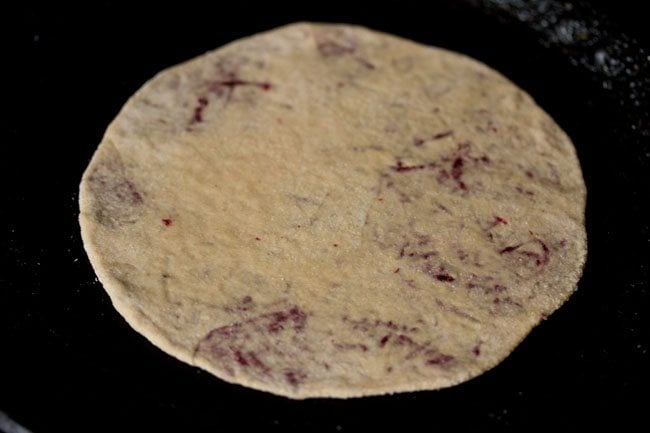
10. On a medium to high heat, begin to roast the paratha.
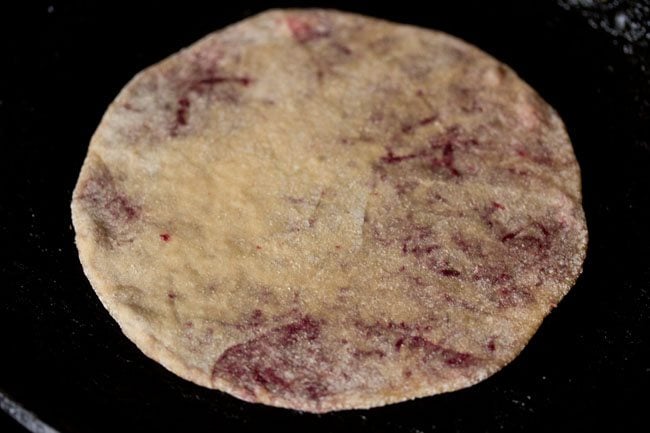
11. When one side is partially cooked (about ¼th) then flip the paratha using a spatula or tongs.

12. Spread some oil or ghee on top using a spoon. The amount of oil to be spread depends upon your preference.
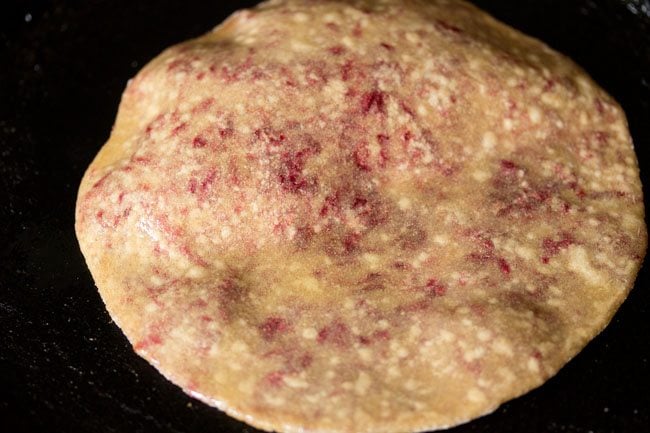
13. Flip again.
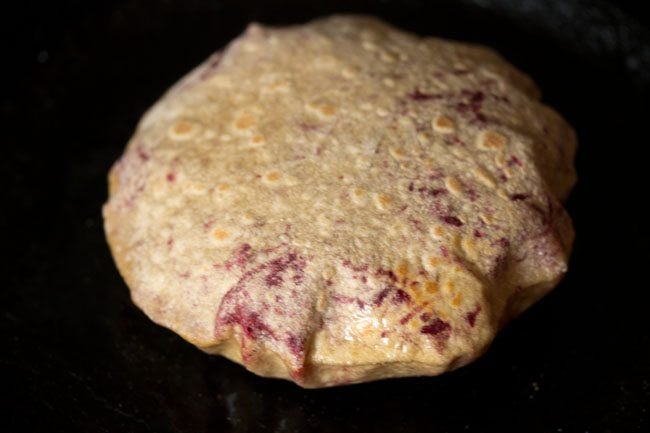
14. Now spread some oil or ghee on this side too. If the paratha has been stuffed and rolled well, it will start puffing up while cooking.
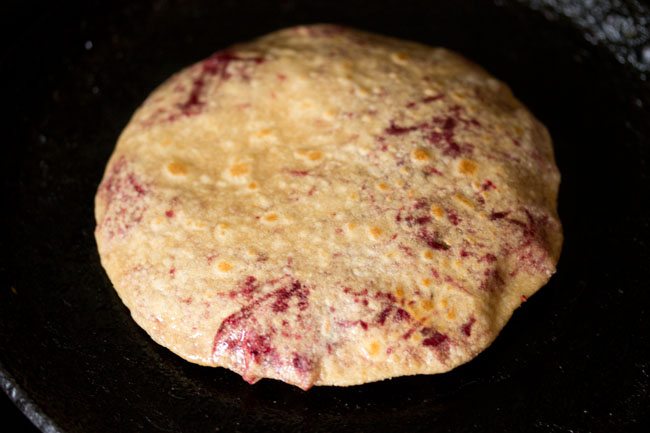
15. Flip again using a spatula or tongs.
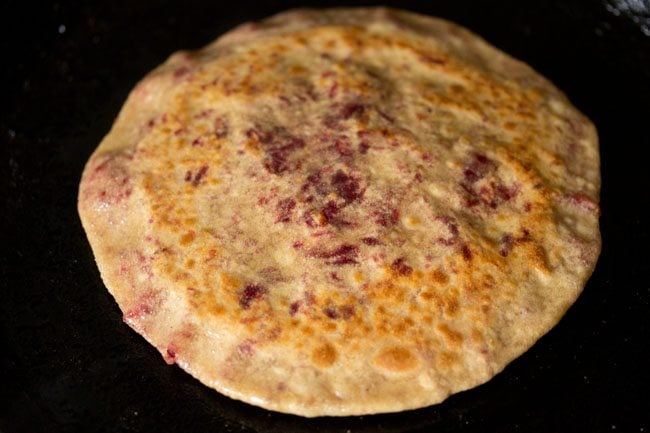
16. Press the paratha edges with a spatula too, so that they are also roasted well and do not remain uncooked. Sometimes it helps to press the paratha edges with a spatula for even cooking.
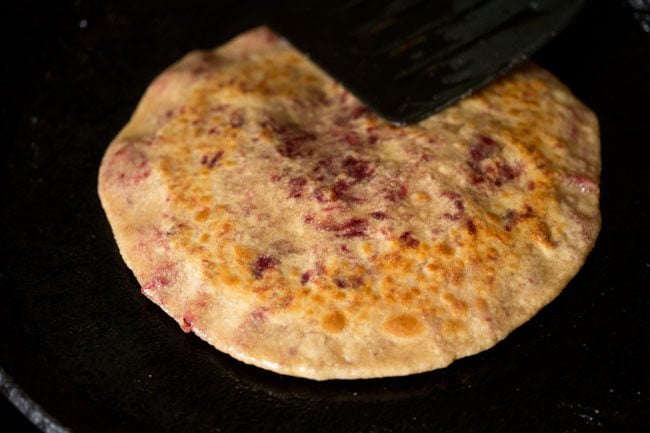
17. Flip once more and roast till the paratha is evenly cooked and has golden blisters on top.
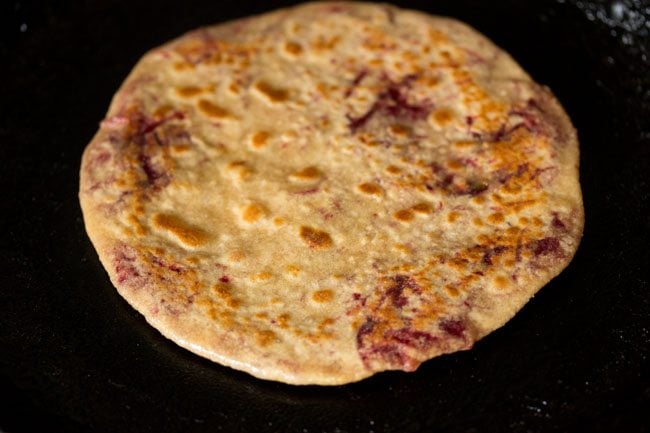
18. Serve beetroot paratha hot or warm with a raita or yogurt or pickle. You can also stack them in a roti basket and later serve warm.
You can serve them for breakfast or lunch with a side accompaniment of a sweet mango pickle. They can also be served with some butter or curd.

More Tasty Paratha recipes
Please be sure to rate the recipe in the recipe card or leave a comment below if you have made it. For more vegetarian inspirations, Sign Up for my emails or follow me on Instagram, Youtube, Facebook, Pinterest or Twitter.

Beetroot Paratha
Ingredients
For paratha dough
- 2 cups whole wheat flour
- 2 teaspoon oil
- ½ teaspoon salt
- ½ to ⅔ cup water or add as required
For paratha stuffing
- 1 teaspoon oil
- 350 grams beetroot or 4 medium-sized beetroots or 2 cups tightly packed grated beets
- 1 to 2 green chilies, finely chopped
- 1 teaspoon dry mango powder (amchur powder) or dry pomegranate powder (anardana powder)
- ½ teaspoon Garam Masala
- salt as required
- oil or ghee as required for roasting
Instructions
Making dough for paratha
- First take whole wheat flour, salt and oil in a mixing bowl or pan. Mix very well.
- Then add ½ cup water.
- Begin to knead. Add more water if required while kneading.
- I added overall ⅔ cup water. Depending on the quality of flour, you can add less or more water.
- Knead to a soft and smooth dough. Cover the bowl with a lid and keep aside the paratha dough for 30 minutes.
Making beetroot paratha stuffing
- Rinse, peel and grate 350 grams beetroot or 4 medium sized beetroots. You should be able to get 2 cups tightly packed beetroots.
- Heat a pan and add 1 teaspoon oil. Then add the grated beetroot.
- Saute the beetroot on a low heat for 5 to 6 minutes, till there is no moisture in them. They will be partly cooked and also appear dry.
- Now add the following seasonings – finely chopped green chilies, dry mango powder or dry pomegranate powder, garam masala powder and salt as required.
- Mix very well. Switch off the heat. Keep the beetroot mixture aside. Ensure that there is no water in the stuffing. Otherwise the paratha can become soggy while rolling and roasting.
Rolling stuffed beetroot paratha
- Pinch medium sized balls from the dough. Roll them and keep covered.
- Take a dough ball. Flatten it a bit. Sprinkle with some whole wheat flour.
- Roll to a round of 5 to 6 inches in diameter.
- Place 2 to 3 tablespoons of the beetroot stuffing on the rolled dough.
- Begin to pleat the edges.
- Then bring them together at the center and press them at the center.
- Flatten the pressed edges with your fingers and dust some flour on the stuffed dough. You can also roll two small rounds and then place the beetroot between the dough circles.
- Gently roll to a paratha of about 7 to 8 inches. Sprinkle flour as required while rolling.
Making beetroot paratha
- Heat a tawa or skillet and let it become hot. Place the paratha on the hot skillet.
- On a medium to high heat, begin to roast the paratha. Avoid roasting the paratha on a low flame as then they will become hard or dense and won't taste good.
- When one side is partially cooked (about ¼th) then flip with a spatula.
- Spread some oil or ghee on top and flip again.
- Now spread some oil or ghee on this side too. If the paratha has been stuffed and rolled well, it will start puffing up while cooking. Flip again.
- Press the paratha edges with a spatula too, so that they are also roasted well.
- Flip once more and roast till the paratha is evenly cooked and has golden blisters on top.
- Serve beetroot paratha hot or warm. You can also stack them in roti basket and later serve warm. Serve them for breakfast or lunch with a side accompaniment of a sweet mango pickle. You can also serve with some butter or curd or have them plain with a cup of tea.
Notes
- You can adjust the spices and herbs according to your preferences.
- Make sure to knead the dough very well. It should be soft, smooth and pliable. If the dough is not soft then the paratha can become dense or chewy.
- You can use oil or ghee to roast.
- If making for lunchbox or breakfast then you can prep the filling a night before and refrigerate.
- You can easily double or triple this recipe if you want to make more parathas.
Nutrition Info (Approximate Values)
This Beetroot Paratha post from the archives (July 2016) has been republished and updated on 13 September 2021.









Yes, we followed this recipe exactly and have just enjoyed these paratha’s with a hot curry.
Thank you for sharing your recipe and technique – well done 🙂
Thanks for the prompt reply. Now I know the reason. The filling was not evenly distributed and came out in a few places.Next time I will keep these points in mind.
Thanks once again for the simple and wonderful recipes that you post and for making our lives easier.May God bless you abundantly.
welcome winnie. sure and thank you again for your kind wishes and this sweet comment. it does make me feel both humble and grateful too.
I used boiled beetroots here so skipped the sauteing part for the filling.while the parathas were super tasty and soft,they did not puff out at all as shown.the dough was soft and kneaded well.i did not keep the dough for 30 mins.as mentioned.could this be the reason? Other than this it was good.
winnie, when the parathas are rolled evenly and the filling does not come out, then they puff up very well. even rolling is the key to get puffed parathas. the filling also has to distribute evenly. resting dough does help, but when short of time resting the dough can be skipped. hope these suggestions help and thanks for the feedback.